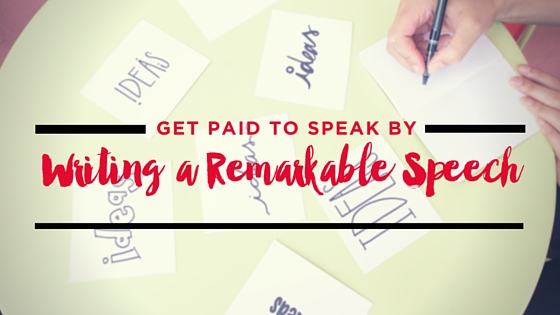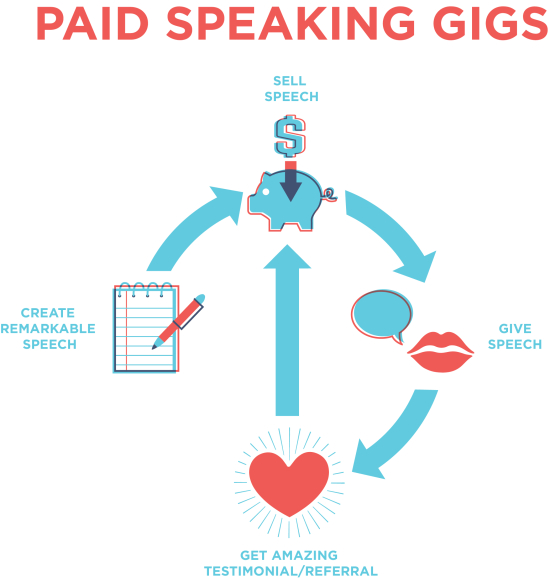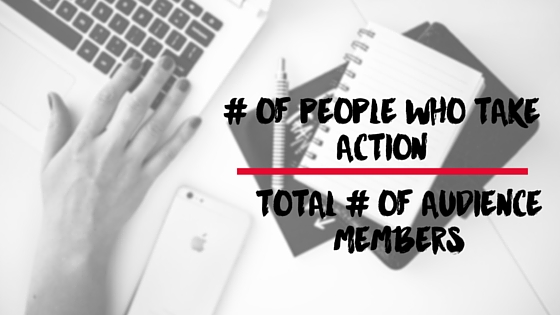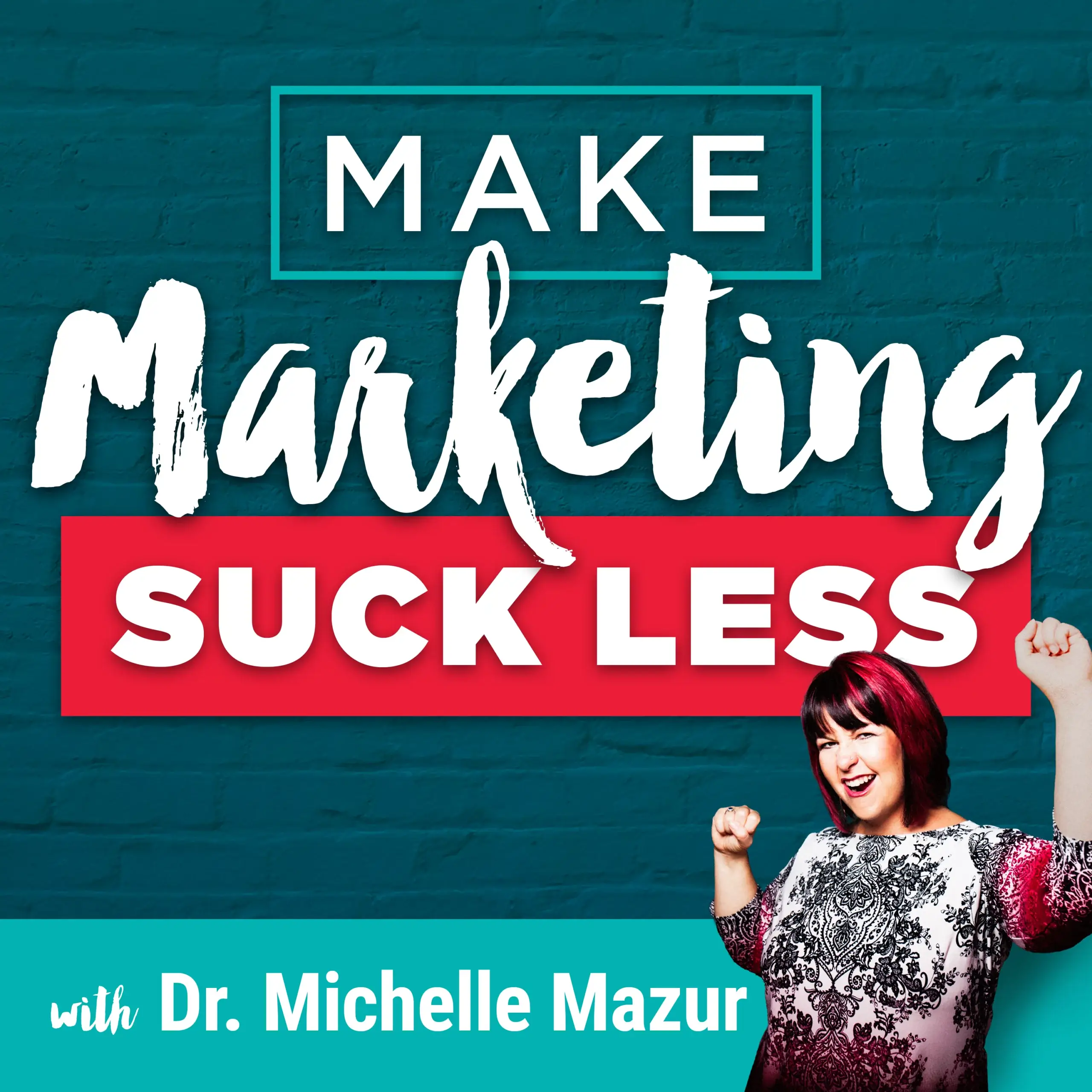Make Marketing Suck Less
How to Get Paid to Speak by Writing a Remarkable Speech
By Michelle Mazur > March 1, 2016
Filed Under Public Speaking

You are a sponge for speaking knowledge. You’re reading blog posts and books. Listening to podcasts galore. Gleaning all the information you can about writing a speech that helps you get paid to speak.
But there’s one place I know you’re still getting tripped up on and that’s how to land speaking gigs.
Consistently booking speaking gigs feels like a big mystery to you. Like those speakers that you see on stage know something that you don’t. That there’s some big secret that you haven’t been told about how to have a steady stream of new opportunities coming your way.
I’ve spent the past few years obsessed with why some speakers thrive while others barely survive.
Allow me to unlock that mystery for you.
The difference between you and those speakers is that the most successful speakers take their heart-felt stories and ideas and turn those into a speech that’s an asset to their business.
Creating and delivering a remarkable speech is the BEST way to attract more speaking opportunities.
I’m going to walk you through my personal step-by-step approach. This is what I use with my clients who are all speaking around the world right now. This approach can help you create a speech that will attract speaking gigs to YOU.
Table of Contents
- 1 Step 1: Change the way you think and approach writing for your speaking
- 2 Step 2: Get Paid to Speak by Creating a path to revenue for your speech
- 3 Step 3: Understand the conversation your speech is a part of
- 4 Step 4: What does your audience look like before and after your speech?
- 5 Step 5: What’s your audience’s biggest challenge?
- 6 Step 6: How do you provide a unique solution to that challenge?
- 7 Step 7: Develop your BIG IDEA statement
- 8 Step 8: Use your audience “before and after,” the unique solution, and your BIG IDEA statement to develop your MVP
- 9 Step 9: Develop a feedback plan
- 10 Step 10: Deliver your speech (This is the fun step)
- 11 Step 11: Reiterate, refine and polish your MVP until it’s a product that attracts speaking gigs
Step 1: Change the way you think and approach writing for your speaking
Before we start, let me give you a swift kick in the mindset.
What I am proposing in this post is a whole different way to approach your speaking. I’m not going to talk to you about telling your story, sharing your experience, selling from the stage (because yuck), or how to gesture, move, or feel more confident.
I’m going to tell you the secret that successful speakers know about speaking. It’s the secret that will radically change how you write your speech. It’s a secret I figured out thanks to my friend, mentor, and client Tara Gentile.
I became aware of this mindset when I attended Creative Live in San Francisco. Tara and I were talking about speaking, and she kept saying how she sells her speech. In fact, she was telling me how many times she has sold the speech that she and I created and how she's gotten something like a 10 or 15-time return on investment from working with me which is remarkable.
The morning after our conversation I suddenly sat bolt upright in bed at 2:30 AM and thought, man, Tara talks about her speech differently than almost anyone I know. You see, Tara views her speech as a PRODUCT of her business. It's an asset. It is something that she sells over and over and over again
Successful speakers – speakers who get paid to speak consistently or attract clients with their speech don’t see their speech as an expression of themselves, a soul-stirring story that they must share, or even a way to change the world (although transformation of the audience is critical).
Successful speakers take those heart-felt stories and big ideas and package it so that their speech as an asset to their business. It’s a product that they sell over and over again to people who book speakers.
Think about your best-selling service. It’s pretty kick ass, right? You spent days, weeks, if not months developing it, testing it, writing sales copy for it, and selling your butt off.
The result: your clients and customers love it. You make money from it. It gets great results, and it makes your clients feel amazing.
You’ve got to apply the same approach to writing your speech as you would to designing any product or service in your business.
A speech is not just a speech – it’s your next best-selling product.
To sell it well, it’s must be REMARKABLE!
Action step: Say this out loud “My speech is a product that generates money for my business, and it must be remarkable.” in fact, say it more than once, say it until you believe it.
Step 2: Get Paid to Speak by Creating a path to revenue for your speech
Now that your mindset is adjusted, let’s start down the path to creating a remarkable speech that’s an asset to your business by deciding how you’re going to make money with this remarkable speech.
Before you start even dreaming about taking center stage, you need to make a very important decision.
You’ve got to figure out how to create revenue from speaking. So let’s talk money, honey. Most speakers go into speaking with zero plans for exactly how they are going to make money from their speech. They write a speech, start speaking for free, keep speaking for free, speak for free some more, and never get off the damn hamster wheel of free speaking.
You are not most speakers because you’re reading this blog post, so let’s figure out how we are going to make you some money, STAT.
There are two paths to being paid for speaking: speeches that you get paid for, and speeches that attract clients.
Each type has it’s own path to revenue, so based on your business model and how you want to add revenue (and how quickly you want to add revenue), you’ll need to make choices about which path to pursue so you can create the right speech for that path.
Path One: Landing Paid Speaking Gigs
Paid speaking can include keynote speeches, breakout session, workshops, trainings. The general gist is that you sell your speech to an organization and get paid to deliver that speech (see chart below).
This path to revenue takes longer to create if you’re just starting out, but can be very lucrative.

Path Two: Client attracting speech
Let’s talk about what a client attracting speech is NOT – it’s not selling from the stage. Selling from the stage is ruining public speaking, and it must die.
Thankfully, I’ve noticed more and more speaking contracts lately that absolutely forbid it.
A client attracting speech is about delivering the best value that you can in your speech, and then give a call-to-action that allows you to take the relationship to the next level.
This call-to-action might be a free consultation (these typical convert around 50% to 60% for my clients) or a lead magnet like a workbook, audio, recorded webinar (lead magnets typically convert around 80% to 90% for my clients).
Whatever your call-to-action, it should introduce a way for the audience to go deeper on your speech topic with you, and a way for you to build a relationship through email.
Yes, email. You’ll get their email address, create a nurture sequence of emails that will eventually invite them to do business with you.
And that’s the path to revenue in a client-attracting speech.

What’s path are you choosing? Paid speaking or client attraction?
It is possible to choose BOTH, but you’ll need to change your signature talk to reflect the nature of each type of speech.
Action step: Choose a path to revenue.
[Tweet “How to Get Paid to Speak by Writing a Remarkable Speech”]
Step 3: Understand the conversation your speech is a part of
Now that you see a path to revenue that gets you paid to speak, you can begin the work of discovering how you stand out as a speaker.
Your presentation is a part of a much larger conversation, and you must position your speaking as an alternative to the conversation already happening in your industry.
Tara Gentile, in her book Quiet Power Strategy asks this question:
“What conversation is your business a part of and what voices in that conversation are your best prospects looking for an alternative to?”
Let’s take this quotation and replace the word business with presentation and prospect with audience.
“What conversation is your presentation a part of and what voices in that conversation is your audience looking for an alternative to?”
Now, you’ve got the question you MUST ask yourself if you’re going to succeed at making money as a speaker.
It’s not difficult, but you must lay the groundwork.
In order to make this research process incredibly easy for you:
Action step: Do the research and see how other speakers talk about your topic (please don’t fall into the comparison trap).
Grab the checklist to write a speech that's an asset to your business
Step 4: What does your audience look like before and after your speech?
It’s easy to get distracted thinking about the HUGE OPPORTUNITY your speaking gig affords you. Your mind quickly turns to thoughts of “I’m going to tell them this and that. Oh and when they hear this their minds will be blown.”
Not so fast, my speaking friend. Writing a speech that your audience wants to hear needs to begin with the audience as they enter the room for your speech. Those eager faces that listen to your every word already possess knowledge about your topic.
You must define the starting point for your audience. What do they already know about your topic? What do they know about you? How do they feel when they walk into the room?
The more you know about the audience, the more you’re able to meet them exactly where they are. When you meet the audience at THEIR starting point, you’ll be able to move them to where you want them to go (which isn’t to buy your stuff).
Now you’re in the head of the people in your crowd. You understand what they know, what challenges them, and how they are feeling.
It’s time to define the end point of your journey. Forget about reverse engineering your speech to make a small pitch, instead give the audience a transformation. A small win that the audience can use and enjoy immediately.
The idea of small wins comes from video games. Ever notice that when you first start playing a game it’s easy? You complete the level. Earn loads of points. Progress quickly.
Video game manufacturers know that to get hooked on a video game, players need small wins so they continue playing even when it gets tough.
Let’s apply this to speaking – when the audience gets a small win; they get addicted to the change you provide. They want more wins, and since you’ve created a change for them, they will look to you for the next win, and the next.

When you write a speech that gives the audience a concrete transformation, you’ve provided them with value. This is where buy-in happens.
Action step: Create an audience before and after picture.
Step 5: What’s your audience’s biggest challenge?
When you’re booked as a speaker, you are paid to speak for your expertise. The audience has a problem, and they need the information swimming in your head.
If you’re like most of my client, it’s easy to start swimming in the sea of possibilities of all the knowledge that you could give to them.
But you’re building a speech like a product here, and you’re not going to be able to solve every problem they have.
Your job as a speaker is to sleuth out the audience’s biggest challenge and write a speech to solve that problem.
And if you don’t know what the problem is that only you can solve? Ask the person who booked you for the gig, find people who belong to the organization where you’ll be speaking, or do a little Internet stalking of the group online.
When I talk to a the person who booked me for a gig, I spend a lot of time talking about how my message can help their audience (and make them look good in the process).
When you stop focusing on “this-is-what-I-am-going-to-tell-them” and deliver on “this-is-what-this-audience-most-needs-from-me”, then your presentation is going to be a success, the audience will turn into advocates, and it will be easier to establish the value you create so you can be paid what you’re worth.
Action step: Decide on the specific problem your speech is going to solve.
[Tweet “A speech is not just a speech – it’s your next best-selling product. “]
Step 6: How do you provide a unique solution to that challenge?
It’s time to create that quick win for your audience by leveraging your unfair speaking advantage.
What’s your unfair speaking advantage? I’m so glad you asked.
Your unfair speaking advantage is made up of what YOU uniquely deliver as a speaker, your ideas, and most importantly the result that you produce for your audience.
Taken together, you’ll be able to create a positioning statement that lets you pitch your speaking on your website, at networking events or even on applications for speakers.
(If you want the whole story on how to uncover your unfair speaking advantage, grab the blueprint).
But for the purposes of writing your speech, let’s focus on the unique result you produce for your audience.
Speeches that stand out to audiences are the ones where the audience is changed by what the speaker says. Speakers who are KNOWN for what they do produce a specific result for the audience. You’re able to sell your speech to organizations and to conferences because of this result.
You can’t SOLVE all of the audience’s problems in a 20-minute, 60-minute or even a 90-minute presentation.
The result that you can deliver must be very, very specific.
So, before you type one word on a PowerPoint slide or jot one point on an outline, figure out the result that you want to produce for your audience. The result a speech can produce falls into one of the three following categories:
- Mindset shift – your audience thinks about your topic differently
- New opportunity – your speech opens up a new possibility for your audience that they haven’t thought of before
- Behavior – your audience adapts a new behavior (think of Amy Cuddy’s TED Talk encouraging us to use the power pose).
Remember, one sentence can cause a huge transformation.
Action Step: Pick the one result that you can produce for the audience.
[Tweet “One sentence in your speech can produce a huge result for your audience”]
Step 7: Develop your BIG IDEA statement
Now that you know the starting point for your audience and the destination of where you speech is going to move the audience. It’s time to develop the BIG IDEA of your presentation.
The BIG IDEA is the ONE (and only one) concept that you want your audience to remember after you finish speaking. It’s what you want to be known for as a speaker, and most importantly it gives the audience a way to spread your message long after you finished speaking.
Without a BIG IDEA, your speech is rudderless, drifting from idea to idea, point to point, with no real destination. Not having a BIG IDEA is why speakers give far too much information, overwhelm their audience, and talk about themselves without understanding why it’s important to the audience.
Your BIG IDEA is the foundational statement of your entire presentation. The BIG IDEA is the length of a tweet (140 characters or less) and typically starts with an action verb.
Here are some examples of BIG IDEA from my clients:
- Mindy Crary:“Expect more from your money.”
- Erica Loren: “Happiness is not a luxury it’s a mission critical work ethic.”
- Tara Gentile: “Stop squeezing your business into someone else’s formula.”
The BIG IDEA serves as the lighthouse in the storm of ideas when you’re writing your presentation. It’s the bar that is set to decide what content, stories, statistics, and research should be included.
Action step: Write your BIG IDEA statement. Keep it to the length of a tweet and make it action oriented.
Step 8: Use your audience “before and after,” the unique solution, and your BIG IDEA statement to develop your MVP
You’ve done all the presentation strategy to write your speech or as I like to think about it your minimal viable presentation (MVP).
I’m not going to sugar coat this: writing your MVP is the most difficult part of this entire process. You’ll sit down to start writing, and I guarantee you that resistance will crop up! It’s inevitable.
When you’re feeling stuck agonizing over the direction of your speech or you’re worried that you’re putting too much information into your speech. Bookmark and come back to this post and read these helpful articles and podcasts to get back on track:
- 5 Creative Principles for Remarkable Presentations
- From Idea to Speech: The Creative Process Behind Writing a Speech (Episode 5 of The Rebel Speaker Podcast)
- 7 Strategies to Write Speeches with Ease
Action step: Write your speech, yo!
Grab the checklist to write a speech that's an asset to your business
Step 9: Develop a feedback plan
Speakers are a funny lot because most of us like to be lone wolfs. We lock ourselves away in our offices, write our presentation, practice it in front of our bored-looking cats, and never find or invest in the help we need to drive our speaking forward.
Whoa! That’s a really bad speaking habit. It’s a worse habit than your umm’s or spastic gestures or being so passionate about your topic that you give way too much information.
So what happens when you go it alone is that those messages fall flat, marketing for speaking gigs isn’t as effective as it could be because the product (your speech) isn’t as good as it needs to be, and your business and speaking career doesn’t grow.
There are critical times in your speaking where you absolutely need feedback to ensure that you’re developing the best possible product possible.
You’ve got to have a plan for feedback and a way to measure (yes, I did say measure – we’ll be talking numbers here) your success.
Here are three critical times that you’ll want feedback while creating the product that is your speech:
- Writing Your Speech: Hire a coach like me to help you craft your message, test it out on people who will give you honest feedback
- Working on your delivery: The most effective and efficient way to improve your stage skills is stage time. Work with a coach who specializes in delivering or join Toastmasters.
- Post speaking opportunity: Let me be clear, your audience’s job is NOT to give you feedback on your presentation and speaking skills. You’ll look like an amateur if you ask them for their help instead read step 11 on how to refine your MVP
Action step: Develop and implement your feedback action plan
Step 10: Deliver your speech (This is the fun step)
Woo-hoo! The moment you’ve been waiting for. It’s time to get in front of the audience and give your speech.
You’ve got your feedback plan on hand and your feedback posse in place. Go get ‘em tiger! (Bonus: Read my backstage tour of how I prepare for speaking gigs!)
Action step: Take your speech on the road and see how it goes!
Step 11: Reiterate, refine and polish your MVP until it’s a product that attracts speaking gigs
It’s post speaking gig. Now, it’s time to reflect back and measure the success of your presentation.
Yep by measure I mean numbers. The first number is easy to track and the second number requires math (ack!).
#1: Track how many other speaking opportunities came from this one gig
I tend to be liberal with my definition of speaking gig when I track this number for myself. Speaking opportunities to me mean another speaking gig on stage, a podcast interview, a media opportunity, or an invitation to a telesummit.
Basically any opportunity that I have to get my message to a larger audience counts as speaking.
Your mission (if you choose to accept it) is to define what a speaking opportunity means to you and track that number.
#2: Track your conversion rate
What? Conversion rate? This is speaking not Internet “bro” marketing. Why are you talking about math, Michelle?
I blame Maggie Patterson for this. If you want to learn all you ever would want to know about conversion, head over to her site (but first finish reading this).
If speaking is part of your business model or how you generate awareness for your business model, you must start tracking how well your presentation converts.
Business is a numbers game. What you track grows, and you need to be able to measure how well your presentation is serving you and your business.
I do this by calculating my conversion rate. A conversion rate is simply:
The number of people who took the desired action DIVIDED BY the total number of peeps in the audience:
Let’s say my call to action is buy my book.
At my last speaking gig, I sold 50 books, and there were 100 people in the audience. 50 divided by 100 = 50% conversion rate.
See, math can be totally easy!
From calculating my conversion rate, I know that when I offer a companion workbook that helps the audience implement what I talked about in my speech that converts at 80% to 90%. An invitation to a free consult converts between 60% to 70%.
Since getting people on my mailing list is a high priority for me, I will definitely keep offering the free workbook – who can argue with 80-90%!
See what conversion tells me about my speaking! Cool eh?
You’ve got your numbers tracked so now what?
Your goal is to improve these numbers by improving your speech. How do you do that?
Set your feedback plan into action AND after every speaking gig focus on ONE, not two, not three, not 42, aspect of your presentation that you would like to improve upon for the next time.
Perhaps it’s something about your message or your delivery style. Having one focus will be the most efficient and effective way to improve your presentation.
It’s the best way to not only improve, but to measure how your improvement impacts the number of speaking gigs you’re offered after every presentation AND your conversion rate.
Action step: Track your numbers and pick one aspect of your MVP to improve upon for next time.
If you implement all 11 steps, you’ll have another best-selling product on your hands. You’ll find it easier to pitch yourself for speaking gigs. You’ll be able to highlight exactly how you’re different from other speakers in your field, and show the unique result that your speech provides.
A presentation of this caliber will attract more speaking gigs. You’ll be able to sell this speech to organizations and have a clear path to revenue. Imagine every time you speak knowing that you’ll generate revenue for your business.
What should you do next? Download the checklist, print it out, and keep it with you as you create or polish your speech (aka your new business asset). Then get out there, start developing relationships with people at organizations where you want to speak, and sell your product!
Create Your One-of-a-Kind Message
Your 3 Word Rebellion is the Key to Growing Your Business & Impact






